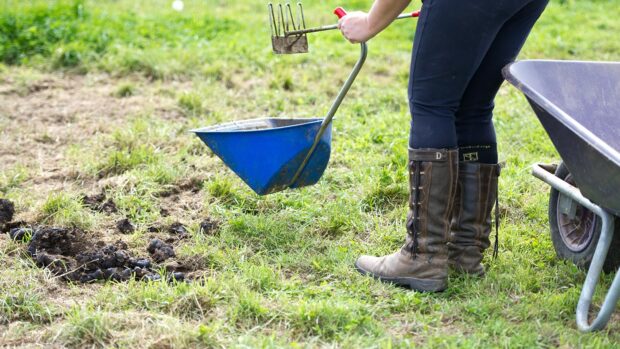Electric fencing for horses is typically used as temporary fencing, for strip-grazing or to protect existing fencing, which is a more permanent fixture. You may also be looking at setting up a track system with electric fencing as it can be easily moved.
If you’re setting up electric fencing for horses for the first time or need to make some upgrades, read on to find out what you’ll need…
What you need for temporary electric fencing
Electric fence starter kits
If you’re setting up your electric fencing for horses from scratch, an electric fencing starter kit could be just what you need. They usually include an energiser, batteries, fence posts and tape, but may also include conductors, ring insulators, a gate handle or a warning sign.
Energiser
The electric fence energiser is the heart of the fencing system and the best option for you depends on the power supply, output required and fence length. If you’re looking for a new energiser and the options below don’t fulfil your needs, we’ve written a specific guide to the best electric fence energisers, too.
Nine-volt battery energisers are a popular choice for strip-grazing and temporary fencing as they are very portable. They are powered by dry-cell 9v disposable batteries, so you will need to consider the cost of replacing them as they run out.
12v battery energisers are ideal for semi-permanent electric fences or where no mains power is available. These are powered by a rechargeable 12v battery and are able to power longer fences at a higher voltage. You could use a car battery, but a purpose-designed leisure battery is designed to give a steady output over time, while a car battery will dwindle quite quickly. The higher the Ah of the battery, the longer you can leave it between recharges.
Solar-powered energisers use energy from the sun to power your fencing setup. They tend to have a higher initial cost but are cheaper in the long run.
Posts
Plastic posts are the most popular for temporary electric fencing for horses – especially for strip grazing – because they’re cheap, lightweight and easy to set up and move. But choosing the right type for you could save you money and hassle in the future. You should consider the…
- height – for some horses, the visual effect of a 3ft post with a couple of lines of tape is enough to command their respect. However, in general, the taller your fence the better – especially if you’re enclosing larger or more determined horses – so 4ft6in fence posts or 5ft fence posts are likely to be a better choice.
- footplate – some posts have a single footplate and if this snaps, it can be hard to replant the post again, while others have a double footplate and some have a stirrup, which is typically more sturdy.
- colour – posts come in a variety of colours (most commonly white, green or black, but you can also get pink, purple or orange). Green is the least lurid and can blend into the surroundings more easily, while some people believe that horses are most respectful of a white fence. Ultimately it’s down to your preference or that of the landowner.
Electric fence tape/rope
Horses need to be able to see your fence for it to act as a deterrent, so the thinnest twines are not suitable. The most popular options for electric fencing for horses are tape and rope.
Electric fence tape is a great choice for plastic posts. It is subject to increased wear in windy conditions, so it’s best not to choose a tape that’s too wide – 20mm tape is suitable for most situations and the most common choice with plastic posts.
Electric fencing rope is visible, very strong and less prone to becoming caught in the wind. It comes in a variety of specifications and strengths – polyropes with stainless steel conductors are ideal for short/medium fence lines, while ropes containing tinned copper conducting lines are better for longer fencing and higher powered energisers. Rope is most commonly used in conjunction with wooden posts.
Connectors
It’s best to avoid cutting your tape where possible. If you need to connect two lines of fencing tape together, you should use tape connectors to ensure good conduction rather than tying the tapes together.
Insulators
Insulators direct your conducting tape or rope and are vital to an efficient electric fence. They’re essential if you have wooden posts as, unlike plastic, wood is a poor insulator. If your fence isn’t insulated properly, the power will leak into the earth and your horse will learn there is no need to respect the fence.
Ring insulators are the best option if you’re using polyrope (but can be used effectively with tape, too). They can be used to direct the rope to run above the fence, which prevents cribbing and chewing, or just inside the fence to prevent horses from scratching or leaning on the fencing.
You can also get distance/offset insulators, which are longer, that keep your horses further away from the fencing. Tape insulators are flatter to accommodate the shape of the tape, while combination insulators can be used for rope or tape.
Handles
Handles are essential for creating safe gateways to the field. They allow the current to pass through and complete the circuit while the gateway is closed, while giving you something safe to hold when you need access.
Warning signs
If your field has a public footpath running through it or alongside, it’s a legal requirement to place warning signs on your fencing to alert people to the potential danger.
Fence testers
Fence testers allow you to check the voltage of your fence to make sure everything is working correctly.
How does electric fencing work?
An energiser unit converts power high voltage split-second pulses that are emitted once every one or two seconds. If your horse touches the wire that carries the pulse, the current will pass through him to the ground and he’ll receive a shock. Horses quickly learn to stay away from the fence and it becomes a physical and psychological boundary.
Essential parts of temporary electric fencing
An electric fence is made up of four essential components…
- An energiser converts power from the mains or a battery into high voltage pulses that are emitted once every one or two seconds.
- The conducting tape makes up the actual barrier and carries the current along the fence. If your horse touches the wire that carries the pulse, the current will pass through him to the ground and he’ll receive a shock.
- Insulation stops the power being lost to the earth – if your tape is touching anything other than the posts or insulators, such as a tree, the fence will lose power.
- An earth stake that takes the current back to the energiser.
You might also like:

Electric fence energisers for every setup

Grazing muzzles – what are your options?

The 10 commandments of electric fencing

Do electric fences make horses stressed?
A Swiss study has looked at the effects of electric fencing on horses

Subscribe to Horse & Hound magazine today – and enjoy unlimited website access all year round
Horse & Hound magazine, out every Thursday, is packed with all the latest news and reports, as well as interviews, specials, nostalgia, vet and training advice. Find how you can enjoy the magazine delivered to your door every week, plus options to upgrade your subscription to access our online service that brings you breaking news and reports as well as other benefits.





